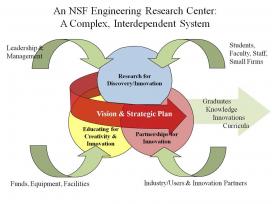What’s an Engineered System?
One of the original drivers of the ERC Program was to provide a new pathway for academic research and engineering education that focuses on the development of next-generation systems. These engineered systems require inputs from several of the traditional disciplines of engineering, rather than just one discipline, and would be developed in collaboration with industry and with eventual commercialization in mind.
We define an engineered system as a combination of components that work in synergy to collectively perform a useful function. The engineered system could, for example, wholly or in part constitute a new technology for a new product line a new manufacturing process, a technology to improve the delivery of a service, or an infrastructure system. Part of the complexity of engineered systems research derives from integrating factors that represent their use in products or services—factoring in their impacts on manufacturing efficiency, the environment, society, or the human body, as appropriate to the system chosen. Therefore, consideration of the complex interactions and effects of the system’s operation is factored into the development, integration, and ongoing management of the components. The vision, strategic research plan, and research program of ERCs enable several crucial steps: i.e., exploring the barriers that stand in the way of realizing the engineered system; enabling an academic-scale proof-of-concept exploration of the system; testing its objectives and performance; and balancing the complexity of its impacts. While high-quality research on one or more of the enabling technological components of such a system is required to realize the functionality of the system, ERCs focus on the integration of the individual components into an engineered system.
Some examples are given here.


